Remington rifle: design could not be simpler

Portrait of Eliphalet Remington from 1845 by an unknown artist. Cowen Auction
and a bullet whistled into the bushes...
You shoot like a soldier, - Kamal said,
“Show me how you drive.”
Rudyard Kipling "The Ballad of West and East". Translation by E. Polonskaya
History rifles. The creation of rifle cartridges with a metal sleeve immediately prompted designers to create a combat weapon for them. weapon. Moreover, in the same USA at that time there was a Civil War between the northern and southern states, and the warring parties needed a lot of weapons. And it was precisely at this very time that “the simplest rifle in the world” appeared, firing metal cartridges. And it was created by an American company owned by Eliphalet Remington.
The future famous gunsmith was born on October 28, 1793, and died on August 12, 1861. Like many other Americans, he was lucky to be born into a family of emigrants from England. As a child, he helped his father, and having become a blacksmith, by the age of 23 he had become such a good craftsman that he was able to make a rifle, for which he forged the barrel himself. True, he still installed a store-bought mechanism on it, purchased from a passing merchant.
The rifle was a success, the technology for its manufacture was worked out by him, so he decided to open his own enterprise for the manufacture of such rifles. I decided and did it. And he named his enterprise very simply: “E. Remington and Son."
The company was registered in the city of Illion, New York, in 1825, after which the father and son worked in it for 19 years, and then they also took their nephew into the business - Philo Remington. Then the children, Samuel and Eliphalet the Third, also got into the family business.
The company expanded and was therefore renamed E. Remington and Sons,” after which it existed under that name until 1888, when management of the company passed to the grandchildren of the company’s founder, Graham and Hartley Remington. The new owners felt that Remington Arms Company sounded much more reputable than the previous name, and changed it for the third time. It still exists under this name today, although it produces not only weapons.
She managed to become famous thanks to her 1863 revolver, which turned out to be so good that it was able to compete with Colt’s own revolvers. Moreover, it was adopted by the American army and was used in the Civil War.
At that time, it was fashionable to produce revolver carbines on the basis of a successful revolver. The Remington company was no exception, but almost simultaneously with revolving carbines, it produced its world masterpiece - a cavalry carbine with a crane bolt or, as they say in English-speaking countries, a “rolling block” bolt.
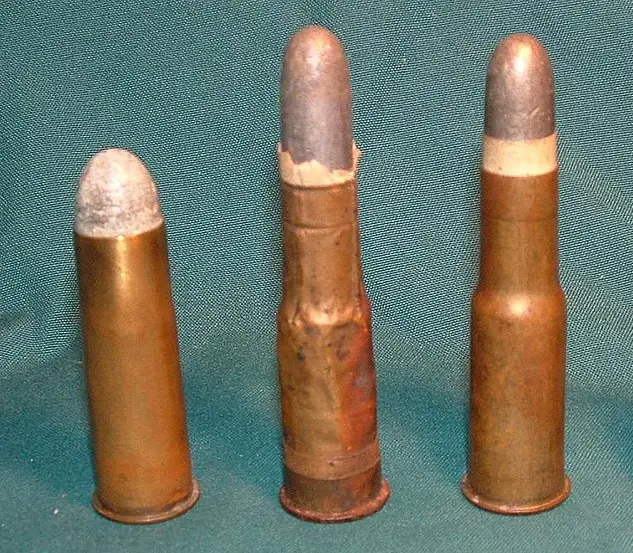
The .577 (14,7 mm) Snyder cartridge (1867), the .577 Martini-Henry cartridge (1871), and the .577/450 Martini-Henry cartridge. Contemporary photography
It is interesting that, as often happened in the history of weapons, it was invented by a complete stranger who had nothing to do with the company: Leonard Geiger. Moreover, Geiger not only, as it turned out, never worked for the Remington family, but never even met any of them.
But the company's employee was another person: Joseph Ryder. And so he designed his shutter almost simultaneously with Geiger. Ryder received his patent on November 15, 1864, and Geiger on April 17, 1866.
And then this is what happened: the Remington company did not sue for violation of the patent rights of its employee and engage in petty litigation, but simply bought Geiger’s patent. This made the two Geiger brothers rich, but now everyone began to call the shutter designed by Leonard Geiger “Remington”!
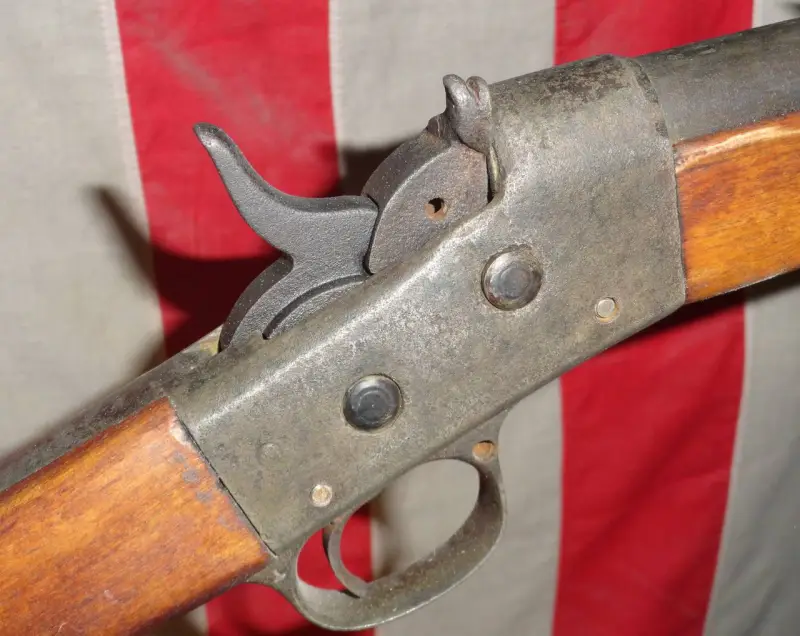
The bolt of a Remington rifle. The shutter is closed, the trigger is pulled. Author's photo
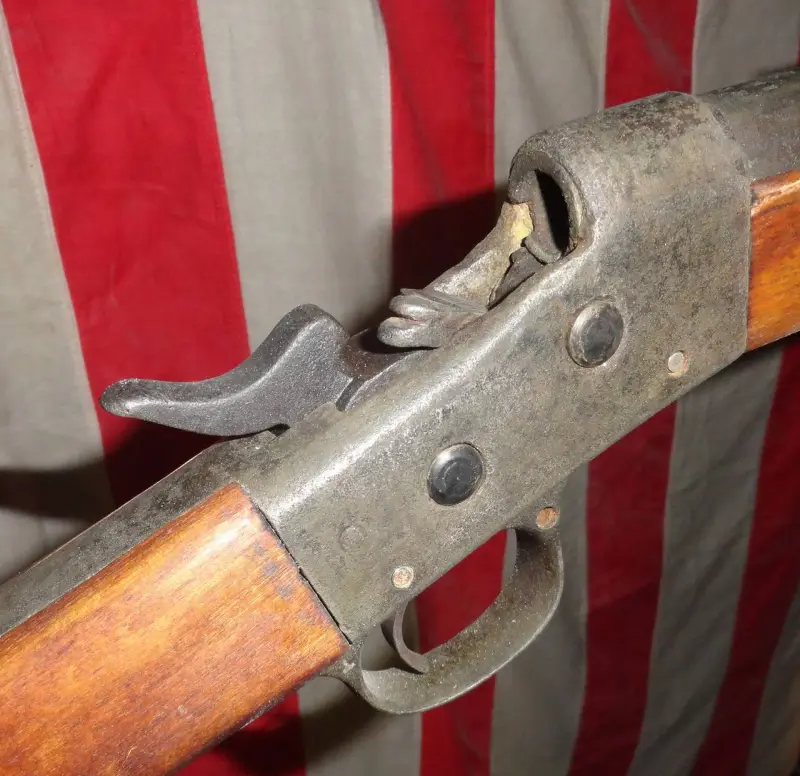
The bolt of a Remington rifle. The hammer is cocked, the bolt is folded back. Author's photo
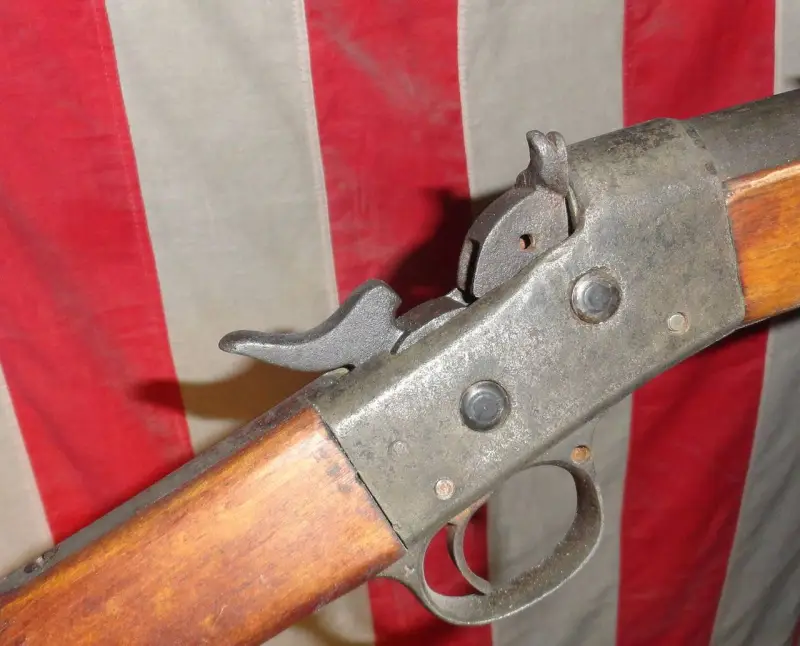
The bolt of a Remington rifle. The bolt is closed, meaning the rifle can be loaded and the hammer cocked. Now all that remains is to press the trigger to fire the shot. Author's photo
Remington also released a rifle, the design of which was based on Ryder’s patent, and called the “Old Model Carbine.” In March 1864, the federal government ordered 1 carbines of this type in .000 (46 mm) caliber chambered for the rimfire cartridge.
In December, the order was increased to 5 copies, with the first 000 carbines manufactured in February 1, more than 250 in March, and the entire order was completed on April 1865, 1.
In October 1864, the company signed a second contract for 15 “second model” carbines firing the .000 caliber (50 mm) Spencer cartridge, also with rimfire. The first 12,7 enlisted in the army in September 1, five months after the end of hostilities.
Well, all the remaining 14 carbines were made by March 000; it turned out that the army did not need them and were transferred to warehouses. But they still had a chance to shoot: in November 1866, the entire supply of the army was bought by Remington and then sold to France, where they were used during the Franco-Prussian War!
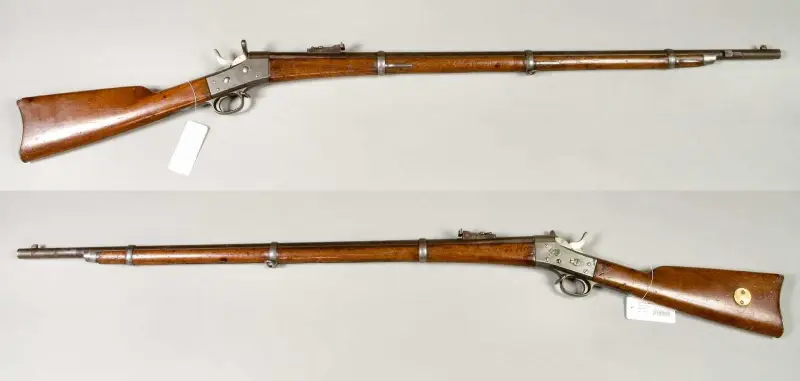
An 1867 Remington rifle produced by the Carl Gustav arms factory in Sweden. Army Museum, Stockholm
It is interesting that General Custer also used the Remington Sporting carbine in the fatal battle with the Indians at Little Big Horn in 1876. And he (although he fought there, being with the rank of colonel), most likely, could afford to purchase any weapon. However, he chose large-caliber and completely unpatriotic Bulldog revolvers and ... a Remington carbine, apparently considering it better than the standard Springfield army carbine!
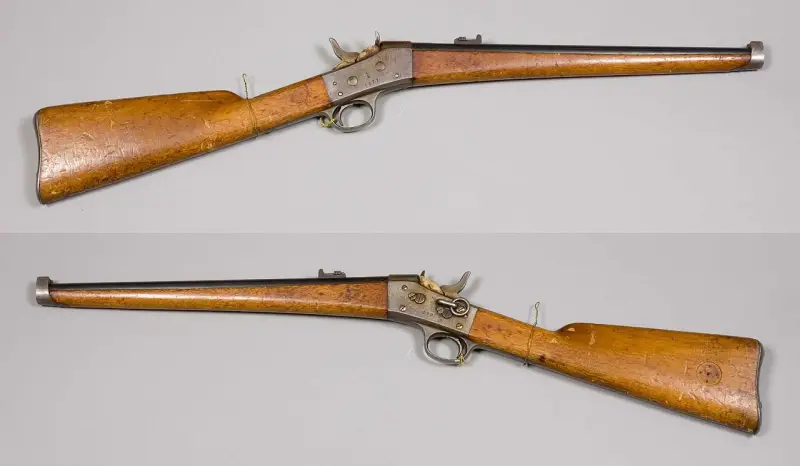
Model 1870 Remington carbine, manufactured by Husqvarna, Sweden. Army Museum, Stockholm
Well, now let's look at this technique itself in metal. After all, before us, absolutely indisputably, is the most ingenious rifle bolt of all times in its simplicity, both in its completeness and reliability.
After all, the shutter has only three main parts, two axles and four springs, not counting the screws. The main parts of everything are the bolt and trigger. Both are large in size and therefore durable, spinning on massive axles so they are as hard to break as a metal ball! The released trigger fits into the middle groove in the bolt and is integral with it.
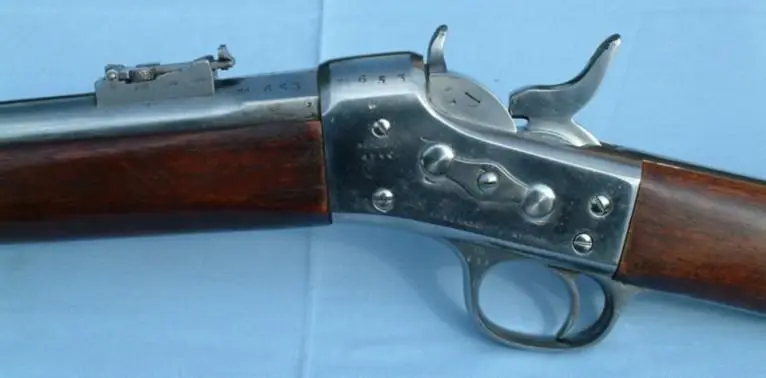
The bolt of a Remington rifle, which was in service with the Vatican's Papal Guard. Manufactured by Nagan. Fastening of the shutter axes using one screwed plate. To disassemble the bolt, it was necessary to first remove this plate, and then easily knock out the axles and remove both the bolt and the trigger. Photography by Alain Dobress
The shutter worked like this.
In order to fire, you had to pull the trigger back with your thumb. Then the U-shaped bolt with finger grooves on the protrusions on the right and left had to be pulled back. Now the cartridge had to be inserted into the chamber and pressed with the bolt, which was spring-loaded from below with a special spring. Now you could aim and pull the trigger. He entered the bolt and firmly propped it up so that no recoil could throw them back. Well, the trigger itself also hit the rim of the cartridge.
After the shot, all this was done in reverse order. At the same time, the extractor pushed out the empty cartridge case, and... the rifle could be loaded again.
From 1867 to 1896, Remington produced a huge number of rifles and carbines chambered for black powder cartridges. For example, in 1869, 125 rifles of this system were supplied to Turkey alone.
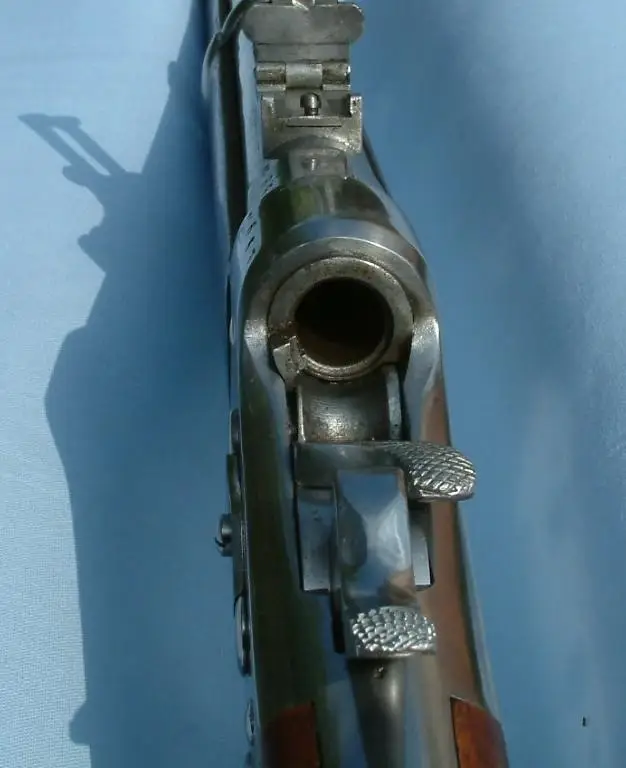
In this photo you can see the following parts of the Remington rifle: the extractor (on the barrel below left), the grooved bolt “spoke” (right) and the same grooved trigger “spoke” (below). The breech is open and a cartridge can be inserted into it. Photography by Alain Dobress
When the central firing cartridge designed by Berdan was born, the company had to remake its bolt to accommodate it. But it all came down to an essentially minor change: a channel for the striker appeared in the bolt. On the right side they made a curved plate (“spoke”) to move it back. And these were all the changes! Now the trigger, hitting the firing pin, as before, firmly locked it in the “dead center”.
And although in 1896 many countries had already switched to multi-shot rifles, Remington still produced its “single-shot” rifles, albeit chambered for smokeless powder, and sold the same number of them around the world. Which, by the way, was facilitated by their multi-caliber nature, that is, they were produced for a wide variety of cartridges: 6 mm (.236 Remington caliber), 7 mm (Mauser cartridges for Spain and Brazil; 7,62 mm (.30 US caliber) and 7,65 mm (Belgium, Argentina, Chile and Colombia).
Why did they attract buyers?
First of all, because of its cheapness - only 15 dollars, including a bayonet. And, of course, they were attracted by its high combat characteristics. For example, the barrel length was 30 inches, although the rifle itself was shorter than many others, and it weighed only about 4 kg with a bayonet. And its rate of fire was higher than that of many repeating rifles, reaching up to 15 rounds per minute.
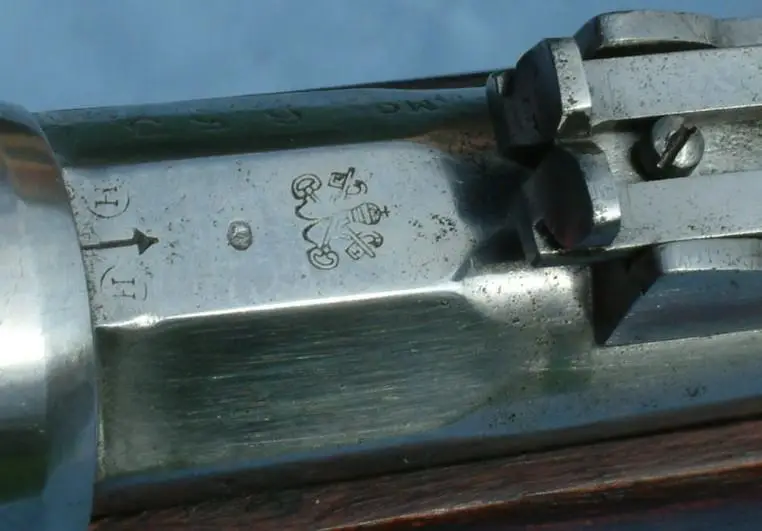
The barrel of a Remington rifle made by Nagan, on which the mark of the Papal Guard is visible. Photography by Alain Dobress
The target firing range was 900 meters, although some rifles had sights set to 1 meters. It was very convenient to disassemble and clean the rifle, and the barrel could be cleaned on both sides! So it is not at all surprising that the papal guard in the Vatican made Remingtons their service weapon!
But this rifle had a very serious flaw, because of which it eventually left the arena of military weapons.
It was impossible to equip it with a magazine by any means, namely repeating rifles at the turn of the 19th–20th centuries. became the dominant weapon in all armies. But before that happened, there had to be reliable bolt action rifles too!
Information